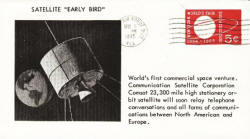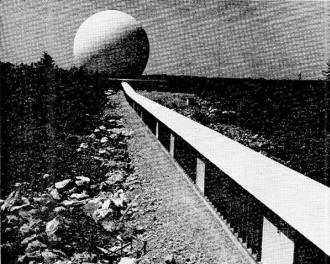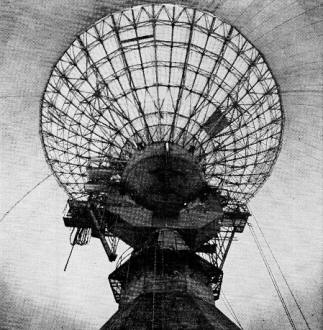Canada's First Satellite Station
|
|
Postcard commemorating the launch of Early Bird (Intelsat I) satellite. Note orbit altitude shown as 23,300 miles (should be 22,300 miles). Many versions of this are on the Web. In 1967 when this story about Canada's first satellite earth station, located 85 miles north of Halifax, Nova Scotia, appeared in Radio-Electronics magazine, government bureaucrats who oversaw the allocation of operational privilege within the realm of electromagnetic radiation worked at the Department of Transport. To some extent that makes sense since information is being transported from point A to point B. That department presently is titled Transport Canada. However, control of the EM spectrum is now the purview of the Canadian Radio-television and Telecommunications Commission (CRTC), which is the equivalent of the U.S.'s Federal Communications Commission (FCC). What would the world do without ever-expanding governmental powers over industry and society? We are truly blessed to have such supremely wise, intelligent, sentient beings controlling everything. No wonder today's world is so orderly and just ...but I digress. This antenna was one of only three such installations at the time in North America. Satellites were being launched with a relatively high regularity, so the population grew quickly after that. I double-checked to be sure I did not incorrectly copy the text where the author states a power level of -100 dB. That, of course, should have been dBm, since dB is a unitless ratio, not a power level. A search for an explanation of why satellites are referred to as "birds" did not turn up a definitive source. Supposedly the nickname "Early Bird" for Intelsat I stemmed from the old saying "the early bird catches the worm'" i.e. dominating the satellite industry. Other sources say "bird" refers to the satellite's path across the sky or that they have a bird's-eye view of the Earth. I lean toward the latter. Canada's First Satellite StationThe satellite tracking antenna is housed inside the distant radome made of Dacron. The "bubble" is over 100 feet high. By James W. Essex With the decision of Canada's Department of Transport (equivalent to the US's FCC) to build a satellite receiving station, the northland country is assured participation in the fast-growing chain of international communication satellites. A signatory to the International Agreement covering ownership and use of the system, Intelsat Canada has a 3½% ownership in the corporation which owns and operates satellites Early Bird, Lani Bird and Canary Bird. This percentage may be small, but it is significant as it places Canada fifth on the list of participating nations. It's also worth noting that this northern neighbor of the US boasts one of three commercial satellite-receiving stations in North America, complementing the US stations at Andover, Me., and Brewster Flat, Wash. The site selected for the station is on Canada's thinly populated eastern coast, not far from Halifax, Nova Scotia. Rising high above rocky terrain, the huge Dacron balloon which covers the antenna looms like a giant "puffball." Over 100 feet high, it's an impressive sight. Air pressure from five compressors maintains the form of the dome. The interior is completely unobstructed. The town (Mill Village), near which the station was placed, is located about 85 miles southwest of the port city of Halifax. The site was chosen to provide a near-ideal proximity to Europe and Early Bird. The location also is remote from large built-up areas to minimize electrical interference. Adequate housing is available in the immediate vicinity, as are suitable power-line facilities. In spite of the fact that signals from a synchronous satellite like Early Bird are virtually line-of-sight, the high frequency (4,000 to 6,000 MHz) and low power (3 watts) require an antenna having truly impressive gain and directional characteristics. The cost of this installation ($9 million Canadian) attests to the financial and physical difficulties involved in providing such an antenna. Maneuverability - needed to accommodate the network of satellites that one day will circle the earth - also adds to the cost. Canada plans to be part of this world-wide network of orbiting satellites. Inside the radome stands the giant parabolic antenna. Note the size of the access ladder near the base of the antenna. The Canadian parabolic dish can be constantly checked for precision by focusing it on a "man-made ground satellite." This signal source is actually a miniature version of the real one and is mounted on a steel tower 7 miles from the dish. When triggered by the giant antenna, signals are emitted in much the same manner as from the real satellite. With the exact range and bearing of the ground satellite known, the use of a boresight telescope allows operators to align the antenna visually by peering through an opening in the Dacron balloon covering. High-gain parametric amplifiers having extremely high signal-to-noise ratios amplify the incoming signals. These sensitive circuits operate in a closed-cycle liquid-helium environment within 4.5° of absolute zero, a practice which minimizes random electron noise within the amplifiers. The low-level (-100 dB) signals are then converted to a 70-MHz intermediate frequency using a superheterodyne mixer. The 70-MHz signals are fed to the control room where they are further amplified. The antenna is used both for transmitting and receiving. A duplexer system is used for switching. Two modes of transmission are possible - SSB and FM - using two 10-kW transmitters operating in the range of 5,925-6,425 MHz. Other equipment associated with the antenna, including the transmitters, is housed within the dome. A combination administration/control building is located 1,000 feet distant. Interconnecting electrical cables are housed in an above-ground tunnel that runs out to the antenna. After processing, signals from the site are fed into a microwave network with terminals in Montreal and Andover, Me. Remote control of the antenna also is possible from this building. Operation of the station is the responsibility of the Canadian Overseas Telecommunications Corp. (COTC). About 40 persons, staff and scientists, are required to maintain its role in the international network. From the beginning, the station has been "commercial." Its future applications depend, not only on the proper assessment of present uses, but what is yet to be learned from satellite communication practices.
Posted March 6, 2024 |
|



